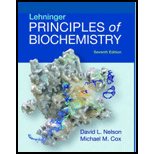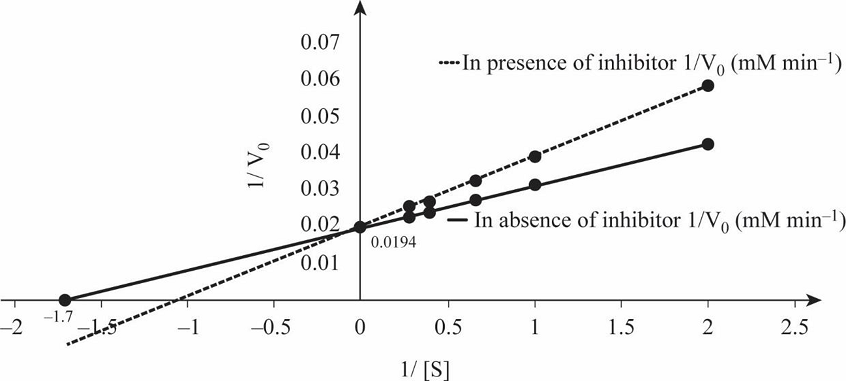
Concept explainers
(a)
To determine: The value of Vmax and Km of enzyme prostaglandin endoperoxide synthase.
Introduction:
Prostaglandin is class of lipid which is present at a site of injury and tissue damage in body. It is involved in healing process and induces inflammation, and initiation of pain.
(a)
Explanation of Solution
Pictorial representation:
Table 1 shows the rate of formation of prostaglandin from arachidonic acid and Fig.1 shows the Lineweaver Burk plot, a double reciprocal plotting for 1/V0 Vs. 1/[S].
Table 1


Fig.1: Lineweaver Burk plot.
Lineweaver-Burk equation is the reciprocal of Michaelis-Menten equation, and given as:
Michaelis-Menten equation
Lineweaver-Burk equation
So, by reciprocating the values given in first and second columns of the given table, we get 1/[S] and 1/V0 values in absence of the inhibitor, as mentioned in Table 1. By plotting these values we obtain the Lineweaver-Burk graph depicted in Fig.1. From the graph, calculating the V max in the absence of inhibitor:
Calculating the Km in the absence of inhibitor:
The Vmax of enzyme in the absence of inhibitor is 51.5mM/min, while Km of enzyme in the absence of inhibitor is 0.59mM.
(b)
To determine: The type of inhibition that ibuprofen exerts on prostaglandin endoperoxide synthase.
Introduction:
Enzyme inhibitors are defined as chemical molecules that bind at active site of enzymes and prevent the binding of substrate with enzyme. There are two types of inhibitors such as reversible and irreversible inhibitors.
(b)
Explanation of Solution
Lineweaver-Burk equation is the reciprocal of Michaelis-Menten equation is given as:
Michaelis-Menten equation
Lineweaver-Burk equation
So, by reciprocating the given values in column first and third, we get the rate of formation of prostaglandin from arachidonic acid in presence of inhibitor ibuprofen, as mentioned in Table 1. By plotting these values we obtain the Lineweaver-Burk graph for 1/[S] and 1/V0 in presence of inhibitor, as depicted in Fig.1.
Calculating the Vmax in presence of inhibitor:
Vmax in the presence of inhibitor:
Km of enzyme in the presence of inhibitor:
The Vmax of enzyme both in the presence and absence of inhibitor is 51.54 mM/min, while Km of enzyme in the presence and absence of inhibitor is 0.83mM and 0.59mM.
Prostaglandin is involved in initiation of pain, and it is synthesized by prostaglandin endoperoxide synthase. Ibuprofen inhibits the activity of this enzyme by binding at the active site and preventing binding of substrate with enzyme. The double reciprocal graph in Fig.1 shows when competitive inhibitor ibuprofen is present, the Vmax remains unchanged while Km increases. Thus, -1/Km value is closer to the origin in the graph depicted in Fig.1. In competitive inhibition, Vmax remains unchanged while Km increases. Therefore, ibuprofen is a competitive inhibitor of prostaglandin.
The inhibition of prostaglandin by ibuprofen is example of competitive inhibition.
Want to see more full solutions like this?
Chapter 6 Solutions
Lehninger Principles of Biochemistry
- Br Mg, ether 1. HCHO (formaldehyde) 2. H+, H₂O PCC 1. NH3, HCN ? (pyridinium chlorochromate) 2. H2O, HCI 11. Which one of the following compounds is the major organic product of the series of reactions shown above? Ph. Ph. OH NH2₂ A Ph. Ή NH2 B OH Ph Η Ph OH NH2 NH2₂ NH₂ C D Earrow_forwardB A 6. Which ONE of the labeled bonds in the tripeptide on the right is a peptide bond: H₂N N 'N' OH C H A, B, C, D or E? HN E OHarrow_forwardQuestions 8-9 are 0.4 points each. The next two questions relate to the peptide whose structure is shown here. To answer these questions, you should look at a table of H2N/.. amino acid structures. You don't have to memorize the structures of the amino acids. IZ 8. What is the N-terminal amino acid of this peptide? A) proline B) aspartic acid C) threonine 9. What is the C-terminal amino acid of this peptide? A) proline B) aspartic acid C) threonine N OH D) valine E) leucine D) valine E) leucine NH "OH OHarrow_forward
- 7. What is the correct name of the following tripeptide? A) Ile-Met-Ser B) Leu-Cys-Thr C) Val-Cys-Ser D) Ser-Cys-Leu E) Leu-Cys-Ser H₂N!!!!! N H ΖΙ .SH SF H IN OH OHarrow_forwardPlease draw out the following metabolic pathways: (Metabolic Map) Mitochondrion: TCA Cycle & GNG, Electron Transport, ATP Synthase, Lipolysis, Shuttle Systems Cytoplasm: Glycolysis & GNG, PPP (Pentose Phosphate Pathway), Glycogen, Lipogenesis, Transporters and Amino Acids Control: Cori/ Glc-Ala cycles, Insulin/Glucagon Reg, Local/Long Distance Regulation, Pools Used Correctlyarrow_forwardPlease help provide me an insight of what to draw for the following metabolic pathways: (Metabolic Map) Mitochondrion: TCA Cycle & GNG, Electron Transport, ATP Synthase, Lipolysis, Shuttle Systems Cytoplasm: Glycolysis & GNG, PPP (Pentose Phosphate Pathway), Glycogen, Lipogenesis, Transporters and Amino Acids Control: Cori/ Glc-Ala cycles, Insulin/Glucagon Reg, Local/Long Distance Regulation, Pools Used Correctlyarrow_forward
- f. The genetic code is given below, along with a short strand of template DNA. Write the protein segment that would form from this DNA. 5'-A-T-G-G-C-T-A-G-G-T-A-A-C-C-T-G-C-A-T-T-A-G-3' Table 4.5 The genetic code First Position Second Position (5' end) U C A G Third Position (3' end) Phe Ser Tyr Cys U Phe Ser Tyr Cys Leu Ser Stop Stop Leu Ser Stop Trp UCAG Leu Pro His Arg His Arg C Leu Pro Gln Arg Pro Leu Gin Arg Pro Leu Ser Asn Thr lle Ser Asn Thr lle Arg A Thr Lys UCAG UCAC G lle Arg Thr Lys Met Gly Asp Ala Val Gly Asp Ala Val Gly G Glu Ala UCAC Val Gly Glu Ala Val Note: This table identifies the amino acid encoded by each triplet. For example, the codon 5'-AUG-3' on mRNA specifies methionine, whereas CAU specifies histidine. UAA, UAG, and UGA are termination signals. AUG is part of the initiation signal, in addition to coding for internal methionine residues. Table 4.5 Biochemistry, Seventh Edition 2012 W. H. Freeman and Company B eviation: does it play abbreviation:arrow_forwardAnswer all of the questions please draw structures for major productarrow_forwardfor glycolysis and the citric acid cycle below, show where ATP, NADH and FADH are used or formed. Show on the diagram the points where at least three other metabolic pathways intersect with these two.arrow_forward
 BiochemistryBiochemistryISBN:9781319114671Author:Lubert Stryer, Jeremy M. Berg, John L. Tymoczko, Gregory J. Gatto Jr.Publisher:W. H. Freeman
BiochemistryBiochemistryISBN:9781319114671Author:Lubert Stryer, Jeremy M. Berg, John L. Tymoczko, Gregory J. Gatto Jr.Publisher:W. H. Freeman Lehninger Principles of BiochemistryBiochemistryISBN:9781464126116Author:David L. Nelson, Michael M. CoxPublisher:W. H. Freeman
Lehninger Principles of BiochemistryBiochemistryISBN:9781464126116Author:David L. Nelson, Michael M. CoxPublisher:W. H. Freeman Fundamentals of Biochemistry: Life at the Molecul...BiochemistryISBN:9781118918401Author:Donald Voet, Judith G. Voet, Charlotte W. PrattPublisher:WILEY
Fundamentals of Biochemistry: Life at the Molecul...BiochemistryISBN:9781118918401Author:Donald Voet, Judith G. Voet, Charlotte W. PrattPublisher:WILEY BiochemistryBiochemistryISBN:9781305961135Author:Mary K. Campbell, Shawn O. Farrell, Owen M. McDougalPublisher:Cengage Learning
BiochemistryBiochemistryISBN:9781305961135Author:Mary K. Campbell, Shawn O. Farrell, Owen M. McDougalPublisher:Cengage Learning BiochemistryBiochemistryISBN:9781305577206Author:Reginald H. Garrett, Charles M. GrishamPublisher:Cengage Learning
BiochemistryBiochemistryISBN:9781305577206Author:Reginald H. Garrett, Charles M. GrishamPublisher:Cengage Learning Fundamentals of General, Organic, and Biological ...BiochemistryISBN:9780134015187Author:John E. McMurry, David S. Ballantine, Carl A. Hoeger, Virginia E. PetersonPublisher:PEARSON
Fundamentals of General, Organic, and Biological ...BiochemistryISBN:9780134015187Author:John E. McMurry, David S. Ballantine, Carl A. Hoeger, Virginia E. PetersonPublisher:PEARSON





